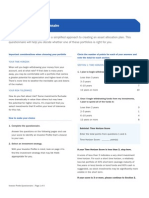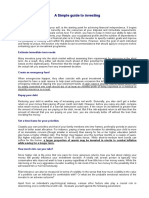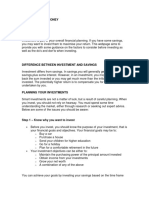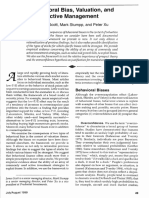Wells Fargo Risk Tolerance Quiz
Wells Fargo Risk Tolerance Quiz
Uploaded by
Piyawut PattamanonCopyright:
Available Formats
Wells Fargo Risk Tolerance Quiz
Wells Fargo Risk Tolerance Quiz
Uploaded by
Piyawut PattamanonCopyright
Available Formats
Share this document
Did you find this document useful?
Is this content inappropriate?
Copyright:
Available Formats
Wells Fargo Risk Tolerance Quiz
Wells Fargo Risk Tolerance Quiz
Uploaded by
Piyawut PattamanonCopyright:
Available Formats
Risk Tolerance Quiz
Create a sound investment strategy
Asset allocation is the process of dividing your investments among the three major asset classes: stocks, bonds, and stable value/money market funds. Its based on the idea that investments can perform differently under the same market conditions. For example, when bonds are performing well, stocks may be down and vice versa. By dividing your investments among the three basic investment categories, you can lower your investment risk and increase the chance of meeting your retirement goals.
Determine your risk profile
Circle the number that most closely fits your personal situation. Then follow the directions at the end of the quiz. 1 DIsAgRee sTRongly 5 AgRee sTRongly To obtain above-average returns on my investments, I am willing to accept above-average risk. staying ahead of inflation is very important to me. If an investment loses money over the course of one year, I can easily resist the temptation to sell it. When I put aside money for retirement, I do not plan on withdrawing from it for major financial expenses. I consider myself knowledgeable about economic issues and personal investing.
1 1 1 1 1
2 2 2 2 2
3 3 3 3 3
4 4 4 4 4
5 5 5 5 5
The Risk Tolerance Quiz is intended to provide you with a general indication of your current investment personality and does not constitute investment advice. Please note that there may be other factors specific to your situation that are not considered in this quiz and your investment personality may change over time.
Understand your tolerance for risk
Add the numbers you circled: ____________ (Compare your total score to the risk profiles below.) ConseRvATIve (5 to 11) Willing to accept lower returns to reduce risk and volatility Would be tempted to sell an investment that lost money in a year MoDeRATe (12 to 18) Willing to accept slightly more risk to obtain better long-term returns May feel nervous about an investment that lost money in a year, but wouldnt be likely to sell AggRessIve (19 to 25) Willing to accept above-average risk to obtain above-average returns Would be comfortable holding on to an investment that lost money in a year
Know your time horizon
your time horizon is the number of years you have before retirement. ______ your expected retirement age ______ minus your current age ______ equals your time horizon
select a sample asset mix
The sample asset mixes below suggest possible investment strategies to achieve a balanced portfolio in line with your risk profile determined on page one. Use the examples below as a starting point for building your own asset mix.
Tip
Investing in a number of different funds and types of funds can spread risk, smooth the ride and potentially enhance returns over the long term.
AsseT AlloCATIon PoRTFolIos Time Horizon Conservative
10% 40% 50% 40%
Moderate
20% 40%
Aggressive
30% 30%
0 to 5 years until retirement
40%
6 to 14 years until retirement
30%
20% 50%
40%
20% 50% 40%
10% 40%
15 plus years until retirement
10% 20% 70% 80%
20%
10% 90%
n stable value/Money Market Funds
n Bonds
n stock Funds
These risk profiles are intended to provide you with a general indication of your current investment personality. There may be other factors specific to your situation that are not considered. Your investment personality may change over time, and you should revisit your situation from time to time to determine if a selected portfolio is still appropriate for your situation. These asset allocation models are based on generally accepted investment theories and take into account historic returns of different asset classes over defined periods of time. These asset allocation models are intended to provide you with general information that may be helpful as you consider your investment options. They are in no way intended to offer advice about which investments to choose or how much to allocate to any particular investment option in the plan. When applying the models to your own situation, you should consider your other assets, income and investments (such as equity in your home, IRA investments, savings accounts, and interests in other qualified and nonqualified plans) in addition to your interest in the plan.
Act with confidence
Review your retirement plans investment options and build your own asset mix. visit your plans website or call a Participant Account services representative.
NOT FDIC INSURED NO BANK GUARANTEE MAY LOSE VALUE
2009 Wells Fargo Bank, n.A. All rights reserved. P64092 7-09
You might also like
- Bwi-Cfq-2013 Portfolio Management QuestionnaireDocument11 pagesBwi-Cfq-2013 Portfolio Management QuestionnaireShravani Kanagala100% (1)
- Risk Profile QuestionnaireDocument5 pagesRisk Profile QuestionnaireSanaullah BughioNo ratings yet
- Investment Fundamentals Guide PDFDocument36 pagesInvestment Fundamentals Guide PDFShashank Gaurav100% (1)
- Investor Profile QuestionnaireDocument3 pagesInvestor Profile QuestionnaireJefferson ButalidNo ratings yet
- Study Guide: Series 7 Top-Off Exam Preparation - Knopman Marks GuideDocument1 pageStudy Guide: Series 7 Top-Off Exam Preparation - Knopman Marks GuideCamilla Talagtag0% (1)
- Aggressive Model PortfolioDocument6 pagesAggressive Model PortfolioNirmaljyoti SharmaNo ratings yet
- Danelia Testbanks Quiz 2345Document46 pagesDanelia Testbanks Quiz 2345Tinatini BakashviliNo ratings yet
- Investor Profile QuestionnaireDocument4 pagesInvestor Profile QuestionnaireSubbu JustcoolNo ratings yet
- Acceptable and Unacceptable AssetDocument3 pagesAcceptable and Unacceptable AssetDenicelle BucoyNo ratings yet
- Risk ToleranceDocument8 pagesRisk Toleranceapi-173610472No ratings yet
- Risk Assessment QuestionnaireDocument7 pagesRisk Assessment Questionnaireamitnpatel1No ratings yet
- FDG Investment QuestionnaireDocument2 pagesFDG Investment QuestionnairejohnSianturiNo ratings yet
- Fidelity's: Top TipsDocument24 pagesFidelity's: Top Tipsmandar LawandeNo ratings yet
- Wealth CreationDocument28 pagesWealth CreationMike Robertson100% (1)
- Client Risk ProfileDocument21 pagesClient Risk ProfileShinchan NoharaNo ratings yet
- Stocks GuruDocument11 pagesStocks GuruTrue 2 lifeNo ratings yet
- The Importance of Diversification: Destruction.)Document4 pagesThe Importance of Diversification: Destruction.)AsfardinNo ratings yet
- Asset AllocationDocument9 pagesAsset AllocationAnil BopteNo ratings yet
- 7956 Risk Profile Questionnaire WhiteDocument5 pages7956 Risk Profile Questionnaire WhitedummyakawntlangtoNo ratings yet
- San DeepDocument17 pagesSan DeepSandeep NedunooriNo ratings yet
- Risk Tolerance QuestionaireDocument4 pagesRisk Tolerance QuestionaireATL3809100% (1)
- What Is InvestmentsDocument9 pagesWhat Is InvestmentsRidwan RamdassNo ratings yet
- RiskProfilingQ EngDocument4 pagesRiskProfilingQ EngcharlestvmNo ratings yet
- PortfolioConstruction & RealEstateDocument18 pagesPortfolioConstruction & RealEstateVamsi TarunNo ratings yet
- What Is Risk?: Investment Pattern On The Basis of Risk Profile of InvestorsDocument4 pagesWhat Is Risk?: Investment Pattern On The Basis of Risk Profile of InvestorsBharath KNNo ratings yet
- Voit Investment Management, LLC: Portf Olio Management QuestionnaireDocument8 pagesVoit Investment Management, LLC: Portf Olio Management QuestionnaireNeha JainNo ratings yet
- Guide To Investing PDFDocument25 pagesGuide To Investing PDFmuralyyNo ratings yet
- Four Steps To Building A Profitable PortfolioDocument6 pagesFour Steps To Building A Profitable Portfoliojojie dador0% (1)
- Investing Your Money: o o o o oDocument8 pagesInvesting Your Money: o o o o oAnna Lina LimosNo ratings yet
- CH 1Document2 pagesCH 1bpsc08No ratings yet
- Chapter - 13 2Document35 pagesChapter - 13 2陈皮乌鸡No ratings yet
- The Fidelity Guide To Equity InvestingDocument16 pagesThe Fidelity Guide To Equity Investingmandar Lawande100% (1)
- 3rd Party Variable Annuity Vask 02-2014Document16 pages3rd Party Variable Annuity Vask 02-2014api-249217077No ratings yet
- Self-Directed Retirement SDSK 02-2014Document16 pagesSelf-Directed Retirement SDSK 02-2014api-249217077No ratings yet
- Asset Allocation and Effective Portfolio Management: Part OneFrom EverandAsset Allocation and Effective Portfolio Management: Part OneRating: 4 out of 5 stars4/5 (3)
- Risk Profile AnalysisDocument5 pagesRisk Profile Analysiss3979517No ratings yet
- Four Steps To Building A Profitable PortfolioDocument5 pagesFour Steps To Building A Profitable PortfolioRaul MarquilleroNo ratings yet
- Investment QuestionnaireDocument6 pagesInvestment QuestionnaireRohit AggarwalNo ratings yet
- Long Term InvestingDocument8 pagesLong Term InvestingkrishchellaNo ratings yet
- Basics of Investing: Erica Abbott & Jean Lown, FCHD Dept., USUDocument37 pagesBasics of Investing: Erica Abbott & Jean Lown, FCHD Dept., USUKenver RegisNo ratings yet
- How To Invest in A Mutual FundDocument4 pagesHow To Invest in A Mutual FundPritesh BhanushaliNo ratings yet
- 10 Investment Basics: /W Epdw Ujnzu0NDocument2 pages10 Investment Basics: /W Epdw Ujnzu0NshailendrNo ratings yet
- Investment Fundamentals GuideDocument36 pagesInvestment Fundamentals GuideHimanshu JauhariNo ratings yet
- Mutual Fund Investor's PerceptionDocument28 pagesMutual Fund Investor's Perceptionamit royNo ratings yet
- Unholy Grails - A New Road To WealthDocument10 pagesUnholy Grails - A New Road To WealthJ RNo ratings yet
- DocumentDocument11 pagesDocumentfireball.vikasproNo ratings yet
- Investing 50s Guide FINALDocument32 pagesInvesting 50s Guide FINALmickxxsNo ratings yet
- Agile Portfolio 2Document9 pagesAgile Portfolio 2quantextNo ratings yet
- 4 Steps To Building A Profitable Portfolio: Chris Gallant Portfolio Asset AllocationDocument5 pages4 Steps To Building A Profitable Portfolio: Chris Gallant Portfolio Asset AllocationRuhulAminNo ratings yet
- Risk & Profile QuestionnaireDocument7 pagesRisk & Profile QuestionnairePrerana JajuNo ratings yet
- Finance Your Future: 6 Things Every Newbie Investor Should DoDocument4 pagesFinance Your Future: 6 Things Every Newbie Investor Should DoBakhshish SinghNo ratings yet
- 4 Steps To Building A Profitable PortfolioDocument4 pages4 Steps To Building A Profitable PortfolioZaki KhateebNo ratings yet
- Sample: Investment Risk Profiling QuestionnaireDocument7 pagesSample: Investment Risk Profiling QuestionnaireVNo ratings yet
- Investing !! What's That?Document37 pagesInvesting !! What's That?sandeep_953No ratings yet
- Do You Know How To Select Debt Funds: Understanding The RiskDocument4 pagesDo You Know How To Select Debt Funds: Understanding The RiskPrashantPachpandeNo ratings yet
- Corporate Financial Risk Management NotesDocument26 pagesCorporate Financial Risk Management NotesThạch DiênNo ratings yet
- FPTM Unit-2Document69 pagesFPTM Unit-2Avneesh RajputNo ratings yet
- Investment QuizDocument14 pagesInvestment QuizNavi KaurNo ratings yet
- Preserving & Growing Your Savings: The Karachi Stock ExchangeDocument2 pagesPreserving & Growing Your Savings: The Karachi Stock ExchangeAyeshaJangdaNo ratings yet
- Forex Survival GuideDocument22 pagesForex Survival Guidevikki2810No ratings yet
- Different Sources of Finance To PLCDocument12 pagesDifferent Sources of Finance To PLCAsif AbdullaNo ratings yet
- Private Debt Primer Oct 2023Document24 pagesPrivate Debt Primer Oct 2023Amber GuptaNo ratings yet
- Economics Notes Which You Shouldnt MissDocument5 pagesEconomics Notes Which You Shouldnt MissVaseem Raza MirzaNo ratings yet
- Management-A Study On Inventory-Nandini RavichandranDocument14 pagesManagement-A Study On Inventory-Nandini RavichandranBESTJournalsNo ratings yet
- Bas430 FPD 7 2021 2Document33 pagesBas430 FPD 7 2021 2Nkhandu S M WilliamsNo ratings yet
- Argania CosmeticsDocument7 pagesArgania CosmeticsEma SousouNo ratings yet
- Lehman US MBS IndexDocument3 pagesLehman US MBS IndexDavid WuNo ratings yet
- Gael Sfeir - CVDocument1 pageGael Sfeir - CVGaelNo ratings yet
- Chapter 15Document126 pagesChapter 15Reg LagartejaNo ratings yet
- Compute For The Price Earnings Ratio If The Earnings Per Share Is PHP 5.50Document3 pagesCompute For The Price Earnings Ratio If The Earnings Per Share Is PHP 5.50Erine ContranoNo ratings yet
- Final Saffron BrochureDocument2 pagesFinal Saffron BrochureArif100% (1)
- Gerresheimer GXI - deDocument11 pagesGerresheimer GXI - deDju DjuNo ratings yet
- Financial Management Chapter 10.1Document33 pagesFinancial Management Chapter 10.1CA Uma KrishnaNo ratings yet
- Consolidated Balance Sheet Balance SheetDocument1 pageConsolidated Balance Sheet Balance SheetMarjuree Fuchsia QuibodNo ratings yet
- Thünen-Series of Applied Economic Theory Thünen-Reihe Angewandter VolkswirtschaftstheorieDocument26 pagesThünen-Series of Applied Economic Theory Thünen-Reihe Angewandter VolkswirtschaftstheorieMohamed YasickNo ratings yet
- Bank Statement1Document17 pagesBank Statement1Jagrar S MessageNo ratings yet
- MBA Semester Ii Fintech Assignment (Digital Asset Market)Document26 pagesMBA Semester Ii Fintech Assignment (Digital Asset Market)Neha ReddyNo ratings yet
- Bbbscamtrackerannualreport Final 2017Document48 pagesBbbscamtrackerannualreport Final 2017KOLD News 13No ratings yet
- ECC Approved Gas Tariff HikeDocument7 pagesECC Approved Gas Tariff HikeUmair malikNo ratings yet
- MCQ of Capital Budgeting Part 2Document4 pagesMCQ of Capital Budgeting Part 2sameerNo ratings yet
- REE REB 2023 FinalDocument7 pagesREE REB 2023 Finalmarveen juadiongNo ratings yet
- Behavioral Bias, Vaiuation, and Active ManagementDocument10 pagesBehavioral Bias, Vaiuation, and Active ManagementDS ReishenNo ratings yet
- Private PlacementDocument50 pagesPrivate PlacementRajesh ChavanNo ratings yet
- Corporate Finance HomeworkDocument3 pagesCorporate Finance HomeworkNguyen Doan Thanh HaNo ratings yet
- The Corporate Form of OrganizationDocument7 pagesThe Corporate Form of OrganizationRabie HarounNo ratings yet
- Corporate Liquidation and Joint ArrangementDocument7 pagesCorporate Liquidation and Joint ArrangementPaupauNo ratings yet

























































































